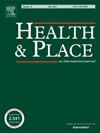Risk of diagnosed and undiagnosed mental distress in coastal and inland English residents: A pooled cross-sectional analysis of adult UKHLS respondents
IF 3.8
2区 医学
Q1 PUBLIC, ENVIRONMENTAL & OCCUPATIONAL HEALTH
引用次数: 0
Abstract
Recent research in the United Kingdom (UK) has highlighted a potential ‘coastal effect’, whereby residents of coastal areas may be subject to poorer health outcomes, including mental health. This study sought to investigate the coastal effect by comparing the risk of experiencing diagnosed and undiagnosed mental distress in both coastal and inland English adult residents. Data from waves 10–13 (2018–2023) of Understanding Society, a nationally representative population study, were extracted for analysis. Respondents were categorised by residential area (coastal or inland), mental health status (no mental distress, diagnosed mental distress, and undiagnosed mental distress), and age category (young adult (16–24 years) (n = 3,615), working age adult (25–65 years) (n = 18,011) and older adult (66+ years) (n = 6,923)). The results of multinomial regression revealed that after adjusting for sex, ethnicity, tenure and household income, young adults residing in the most deprived coastal areas had three times the risk of experiencing undiagnosed mental distress compared to young adults from equally deprived inland areas (RRR: 3.42, 95%CI: 1.24, 9.36). In contrast, older adults in the most deprived coastal areas had approximately one-third of the risk of experiencing undiagnosed mental distress compared with their inland peers (RRR: 0.13, 95%CI: 0.13, 0.95). This research highlights the striking mental health inequality in coastal young adults and calls for investment in both short-term interventions to support mental health and long-term investment in coastal infrastructure and youth mental health services to prevent future generations from experiencing similar mental health disparities.
沿海和内陆英国居民确诊和未确诊精神困扰的风险:对成年UKHLS受访者的汇总横断面分析
联合王国最近的研究强调了潜在的“沿海效应”,即沿海地区的居民可能面临较差的健康结果,包括心理健康。本研究试图通过比较沿海和内陆英国成年居民经历诊断和未诊断的精神痛苦的风险来调查沿海效应。提取了全国代表性人口研究“理解社会”(Understanding Society)第10-13波(2018-2023)的数据进行分析。受访者按居住地区(沿海或内陆)、精神健康状况(无精神困扰、诊断为精神困扰和未诊断为精神困扰)和年龄类别(年轻人(16-24岁)(n = 3,615)、工作年龄成年人(25-65岁)(n = 18,011)和老年人(66岁以上)(n = 6,923))进行分类。多项回归结果显示,在调整性别、种族、权属和家庭收入后,生活在最贫困沿海地区的年轻人经历未确诊精神困扰的风险是生活在同样贫困内陆地区的年轻人的3倍(RRR: 3.42, 95%CI: 1.24, 9.36)。相比之下,与内陆同龄人相比,最贫困沿海地区的老年人经历未确诊精神困扰的风险约为三分之一(RRR: 0.13, 95%CI: 0.13, 0.95)。这项研究强调了沿海年轻人中显著的心理健康不平等,并呼吁对短期干预措施进行投资,以支持心理健康,并对沿海基础设施和青少年心理健康服务进行长期投资,以防止后代经历类似的心理健康差异。
本文章由计算机程序翻译,如有差异,请以英文原文为准。
求助全文
约1分钟内获得全文
求助全文
来源期刊

Health & Place
PUBLIC, ENVIRONMENTAL & OCCUPATIONAL HEALTH-
CiteScore
7.70
自引率
6.20%
发文量
176
审稿时长
29 days
期刊介绍:
he journal is an interdisciplinary journal dedicated to the study of all aspects of health and health care in which place or location matters.
 求助内容:
求助内容: 应助结果提醒方式:
应助结果提醒方式:


